brake fluid CHEVROLET LUMINA 1993 1.G Owners Manual
[x] Cancel search | Manufacturer: CHEVROLET, Model Year: 1993, Model line: LUMINA, Model: CHEVROLET LUMINA 1993 1.GPages: 324, PDF Size: 17.44 MB
Page 150 of 324
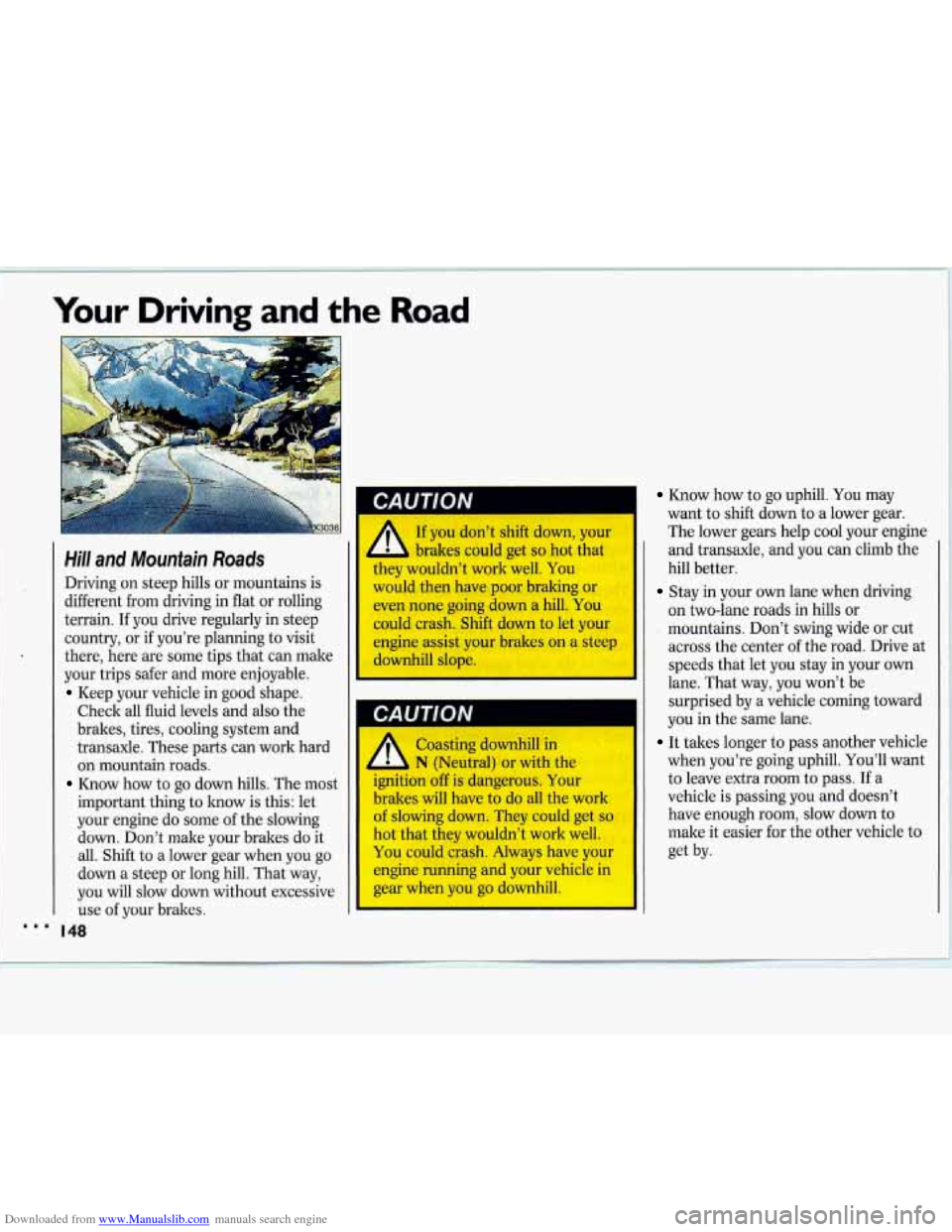
Downloaded from www.Manualslib.com manuals search engine Your Driving and the Road
CAUTION
Hill and Mountain Roads
Driving on steep hills or mountains is
different
from driving in flat or rolling
terrain. If you drive regularly in steep
country, or if you’re planning to visit
there, here are some tips that can make
your trips safer and more enjoyable.
Keep your vehicle in good shape.
Check all fluid levels and also the
brakes, tires, cooling system and
transaxle. These parts can work hard
on mountain roads.
Know how to go down hills. The most
important thing to know is this: let
your engine do some of the slowing
down. Don’t make your brakes do it
all. Shift to a lower gear when you go
down a steep or long hill. That way,
you will slow down without excessive
use of your brakes.
I48
A
If you don’t shift down, your
brakes could get
so hot that
they wouldn’t work well.
You
would then have poor braking or even none going down a hill. You could crash. Shift down to let your
engine assist your brakes on a steep
I downhill slope.
Know how to go uphill. You may
want to shift down to a lower gear.
The lower gears help
cool your engine
and transaxle, and you can climb the
hill better.
Stay in your own lane when driving
on two-lane roads in hills or
mountains. Don’t swing wide or cut
across the center of the road. Drive
at
speeds that let you stay in your own
lane. That way, you won’t be surprised by a vehicle coming toward
you in the same lane.
Coasting downhill in
11 It takes longer to pass another vehicle
N (Neutral) or with the when you’re going uphill. You’ll want
ignition off is dangerous. Your to leave extra room to pass.
If a
brakes will have to do all the work vehicle is passing you and doesn’t
of slowing down. They could get so have enough room, slow down to
hot that they wouldn’t work well. make it easier for the other vehicle to
You could crash. Always have your get by.
engine running and your vehicle in
gear when you go downhill.
i
Page 153 of 324
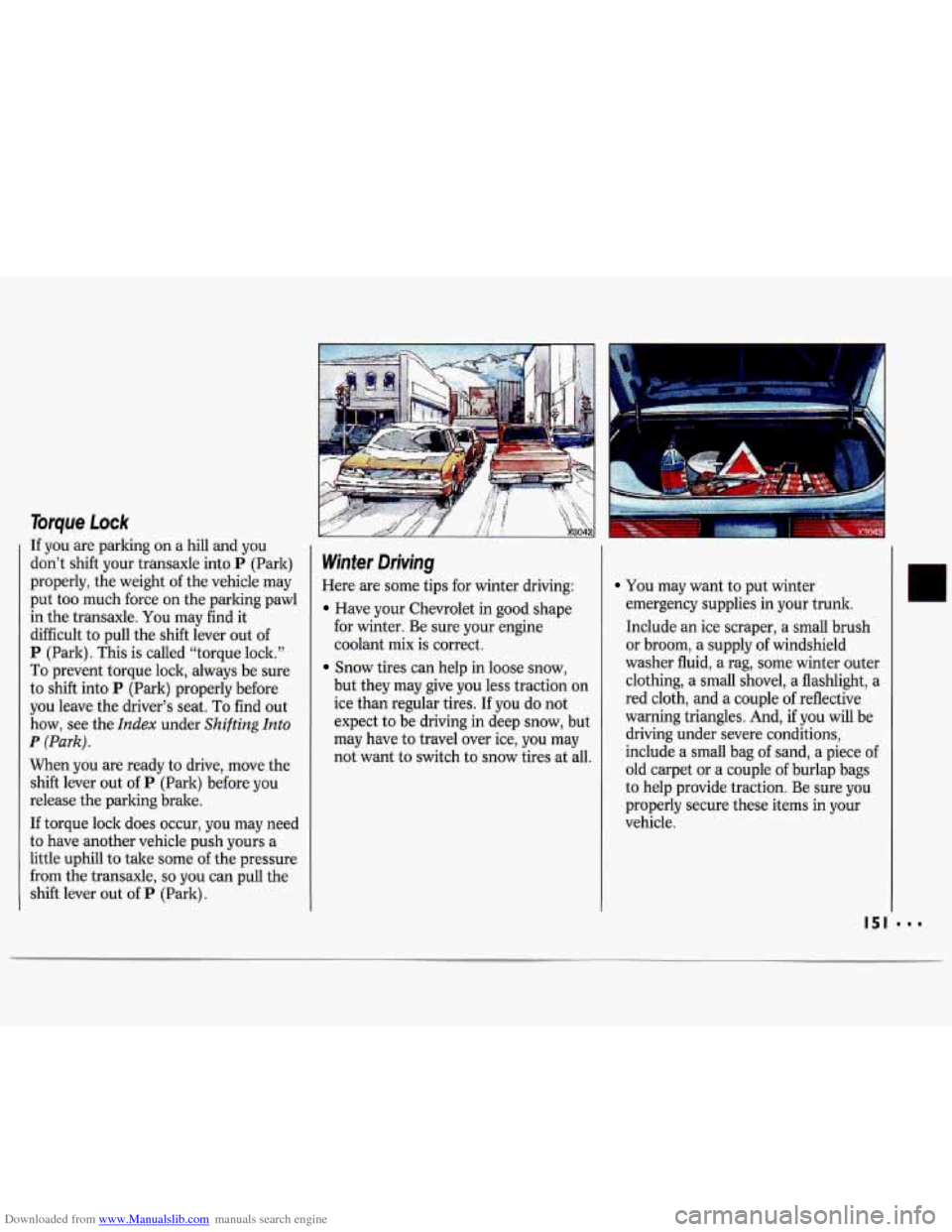
Downloaded from www.Manualslib.com manuals search engine Torque Lock
If you are parking on a hill and you
don’t shift your transaxle into
P (Park)
properly, the weight of the vehicle may
put too much force on the parking pawl
in the transaxle. You may find it
difficult
to pull the shift lever out of
P (Park). This is called “torque lock.”
To prevent torque lock, always be sure
to shift into
P (Park) properly before
you leave the driver’s seat. To find out
how, see the
Index under Shifting Into
P (Park).
When you are ready to drive, move the
shift lever out of
P (Park) before you
release the parking brake.
If torque lock does occur, you may need
to have another vehicle push yours a
little uphill to take some
of the pressure
from the transaxle, so you can pull the
shift lever out of
P (Park).
Winter Driving
Here are some tips for winter driving:
Have your Chevrolet in good shape
for winter. Be sure your engine
coolant mix
is correct.
Snow tires can help in loose snow,
but they may give you less traction on
ice than regular tires.
If you do not
expect to be driving in deep snow, but
may have to travel over ice, you may
not want to switch to snow tires at all.
You may want to put winter
emergency supplies in your trunk.
Include an ice scraper, a small brush
or broom, a supply of windshield
washer fluid, a rag, some winter outer
clothing, a small shovel, a flashlight,
a
red cloth, and a couple of reflective
warning triangles. And, if you will
be
driving under severe conditions,
include a small bag of sand, a piece
of
old carpet or a couple of burlap bags
to help provide traction. Be sure you
properly secure these items in your
vehicle.
151
Page 160 of 324
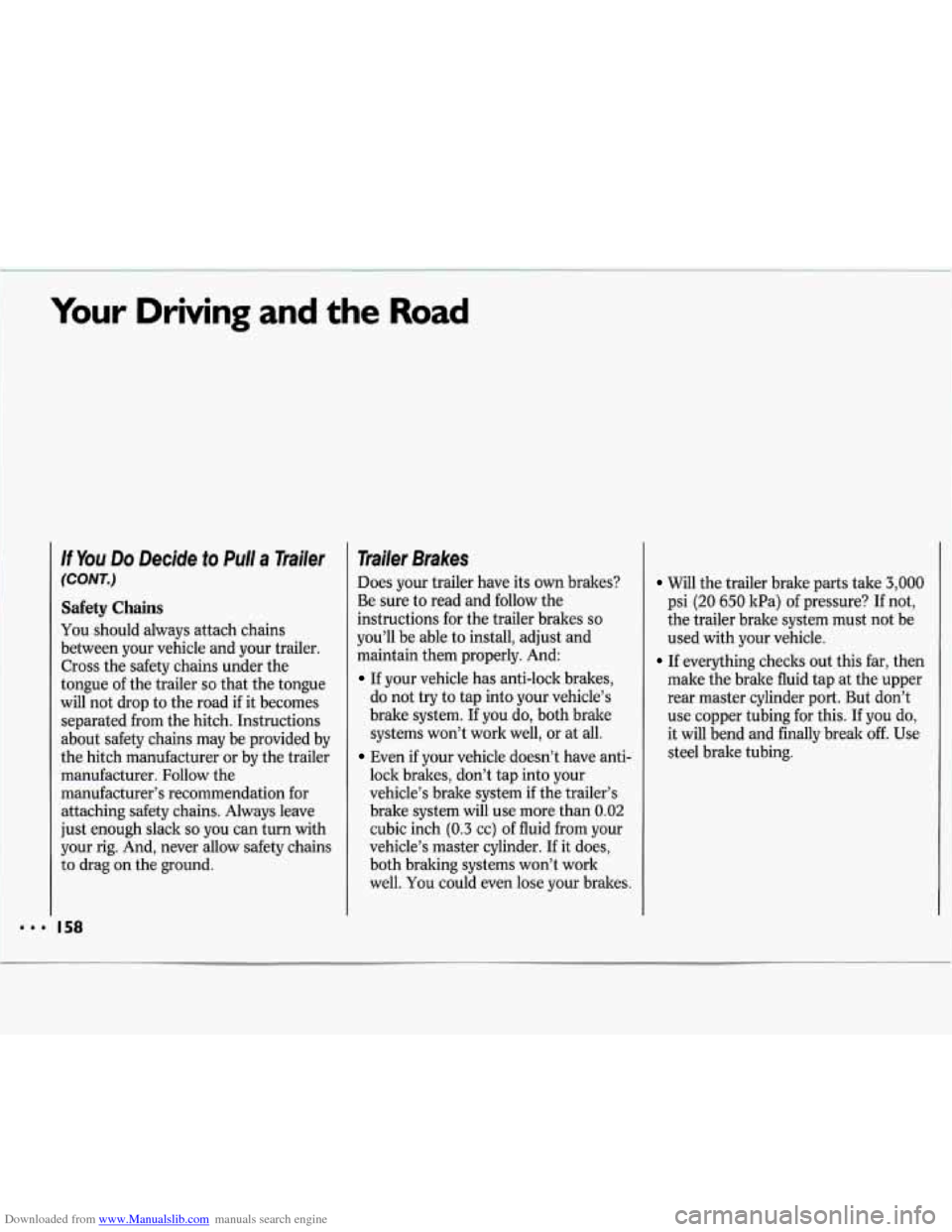
Downloaded from www.Manualslib.com manuals search engine Your Driving and the Road
If You Do Decide to Pull a Trailer
(CONT.)
Safety Chains
You should always attach chains
between your vehicle and your trailer.
Cross the safety chains under the
tongue of the trailer
so that the tongue
will not drop to the road if it becomes
separated from the hitch. Instructions
about safety chains may be provided by
the hitch manufacturer or by the trailer
manufacturer. Follow the
manufacturer’s recommendation for
attaching safety chains. Always leave
just enough slack
so you can turn with
your rig. And, never allow safety chains to drag on the ground.
Trailer Brakes
Does your trailer have its own brakes?
Be sure to read and follow the
instructions for the trailer brakes
so
you’ll be able to install, adjust and
maintain them properly. And:
If your vehicle has anti-lock brakes,
do not
try to tap into your vehicle’s
brake system. If you do, both brake
systems won’t work well, or at all.
Even if your vehicle doesn’t have anti-
lock brakes, don’t tap into your
vehicle’s brake system
if the trailer’s
brake system will use more than
0.02
cubic inch (0.3 cc) of fluid from your
vehicle’s master cylinder. If it does,
both braking systems won’t work
well.
You could even lose your brakes.
Will the trailer brake parts take 3,000
psi (20 650 kPa) of pressure? If not,
the trailer brake system must not be
used with your vehicle.
If everything checks out this far, then
make the brake fluid tap at the upper
rear master cylinder port. But don’t
use copper tubing for this. If you do,
it will bend and finally break
off. Use
steel brake tubing.
Page 163 of 324
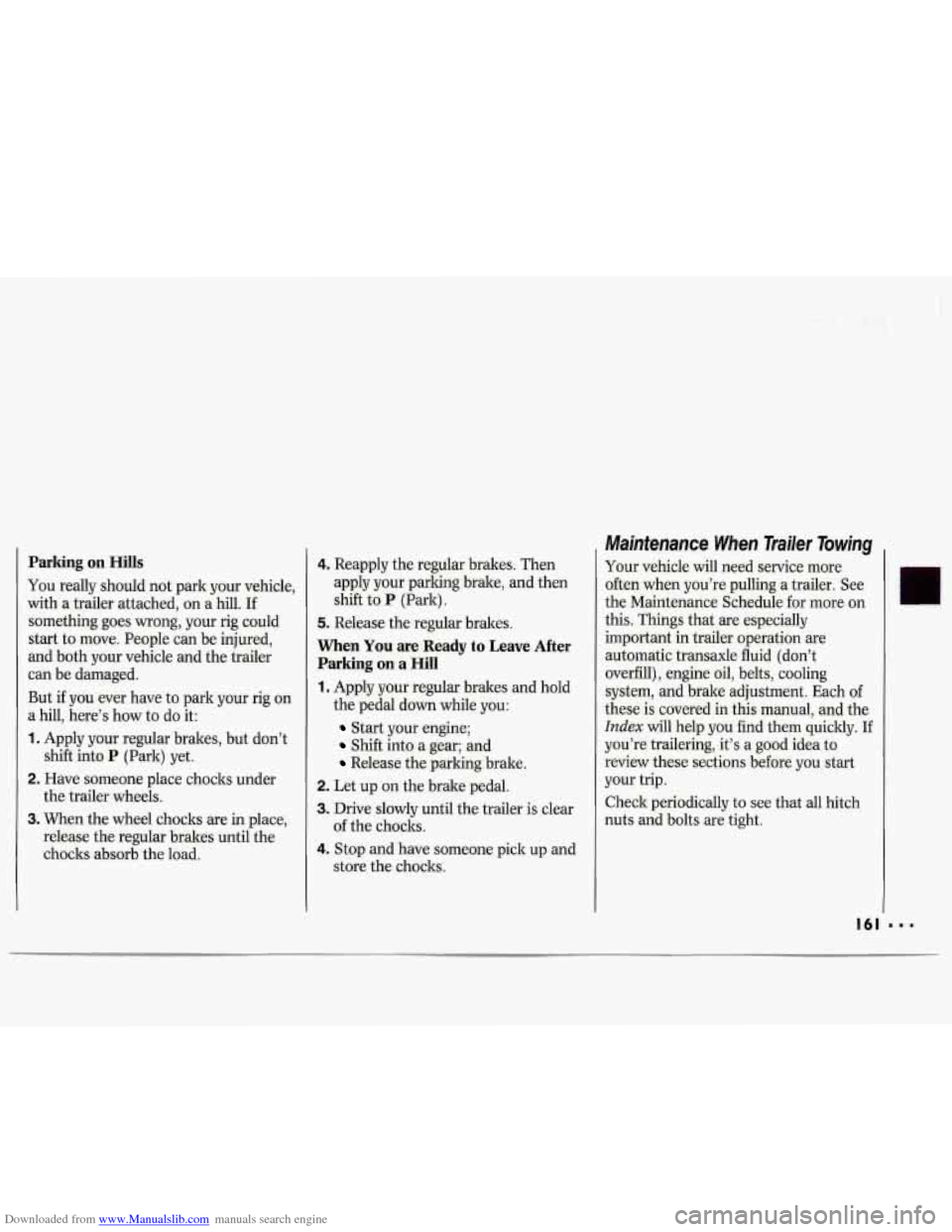
Downloaded from www.Manualslib.com manuals search engine Parking on Hills
You really should not park your vehicle,
with a trailer attached,
on a hill. If
something goes wrong, your rig could
start to move. People can be injured,
and both your vehicle and the trailer
can be damaged.
But if you ever have to park your rig
on
a hill, here’s how to do it:
1. Apply your regular brakes, but don’t
shift into
P (Park) yet.
2. Have someone place chocks under
the trailer wheels.
3. When the wheel chocks are in place,
release the regular brakes until the
chocks absorb the load.
4. Reapply the regular brakes. Then
apply your parking brake, and then
shift to
P (Park).
5. Release the regular brakes.
When You are Ready to Leave After
Parking on a
Hill
1. Apply your regular brakes and hold
the pedal down while you:
Start your engine;
Shift into a gear; and
Release the parking brake.
2. Let up on the brake pedal.
3. Drive slowly until the trailer is clear
4. Stop and have someone pick up and
of
the chocks.
store the chocks.
Maintenance When Trailer Towing
Your vehicle will need service more
often when you’re pulling a trailer. See
the Maintenance Schedule for more
on
this. Things that are especially
important in trailer operation are
automatic transaxle fluid (don’t
overfill), engine oil, belts, cooling
system, and brake adjustment. Each
of
these is covered in this manual, and the
Index will help you find them quickly. If
you’re trailering, it’s a good idea to
review these sections before you start
your trip.
Check periodically to see that all hitch
nuts and bolts are tight.
Page 193 of 324
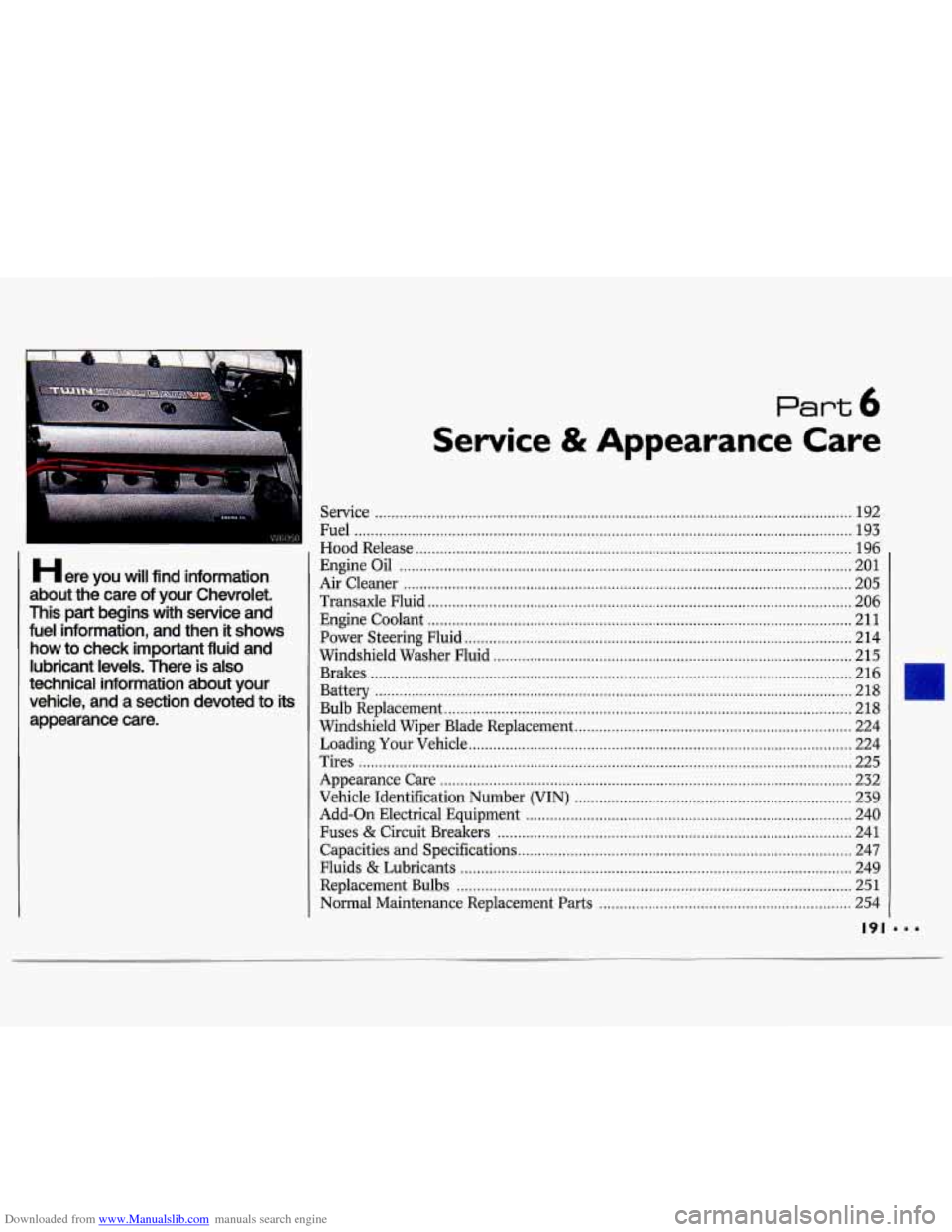
Downloaded from www.Manualslib.com manuals search engine H ere you will find information
about the care of your Chevrolet
.
This part begins with service and
fuel information. and then it shows how to check important fluid and
lubricant levels
. There is also
technical information about your
vehicle. and a section devoted to its
appearance care
.
part 6
Service & Appearance Care
Service ........................................................................\
............................................. 192
Fuel
........................................................................\
.................................................. 193
Hood Release ........................................................................\
................................... 196
Engine Oil ........................................................................\
....................................... 201
Air Cleaner ........................................................................\
...................................... 205
Transaxle Fluid
........................................................................\
................................ 206
Engine Coolant
........................................................................\
................................ 211
Power Steering Fluid
........................................................................\
....................... 214
Windshield Washer Fluid
........................................................................\
................ 215
Brakes
........................................................................\
.............................................. 216
Battery
........................................................................\
............................................. 218
Bulb Replacement
........................................................................\
............................ 218
Windshield Wiper Blade Replacement
.................................................................... 224
Loading Your Vehicle
........................................................................\
...................... 224
Tires
........................................................................\
................................................. 225
Appearance Care
........................................................................\
............................. 232
Vehicle Identification Number (VIN)
.................................................................... 239
Add-on Electrical Equipment
........................................................................\
........ 240
Fuses
& Circuit Breakers ........................................................................\
............... 241
Capacities and Specifications 247
Fluids
& Lubricants ........................................................................\
........................ 249
Replacement Bulbs
........................................................................\
......................... 251
Normal Maintenance Replacement Parts
.............................................................. 254
.. ........................................................................\
..........
Page 199 of 324
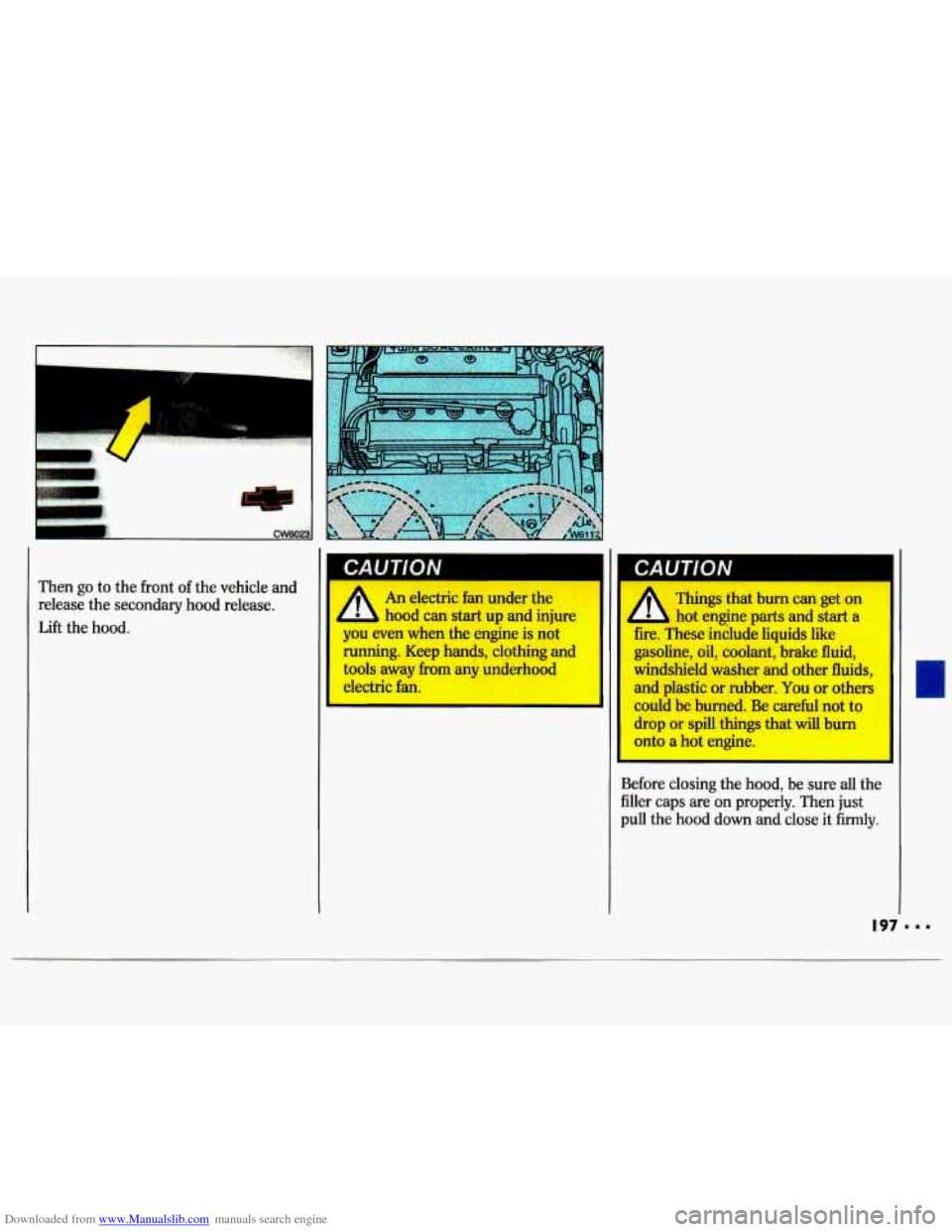
Downloaded from www.Manualslib.com manuals search engine Then go to the front of the vehicle and
release the secondary hood release.
Lift the hood.
An electric fan under the
- hood can start up and injure
you even when the engine is not
running. Keep hands, clothing and
tools away from any underhood
electric fan. A
Things that burn can get on
hot engine parts and start a
I fire. These include liquids like
gasoline, oil, coolant, brake fluid,
windshield washer and other fluids,
and plastic
or rubber. You or others
could be burned. Be careful not to
drop or spill things that will burn
onto a hot engine.
I_ ,.,,.ng be sure all the
filler caps are on properly. Then just
pull the hood down and close it firmly.
I ‘I
Page 200 of 324
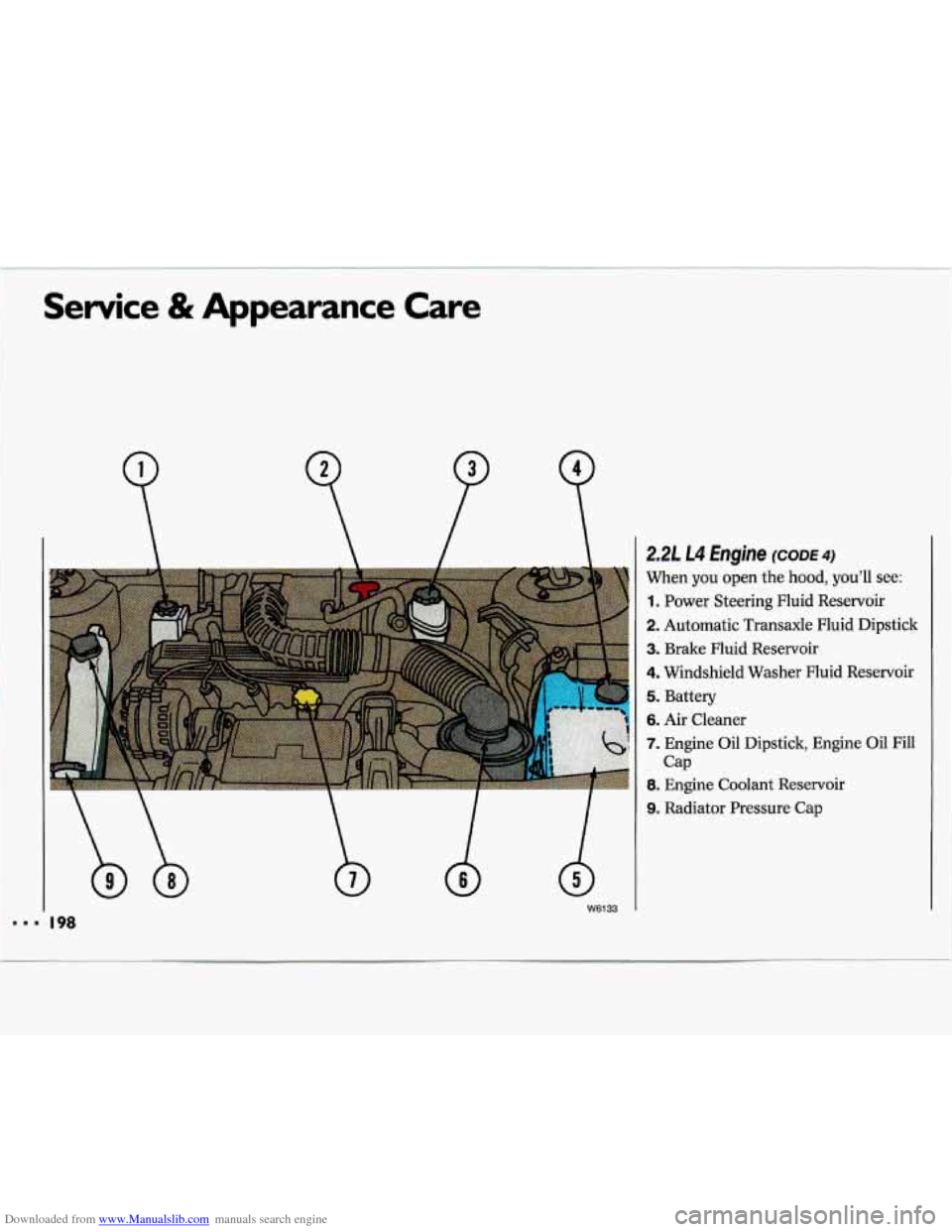
Downloaded from www.Manualslib.com manuals search engine Service & Appearance Care
9 P
. I ...... 2.2L L4 €ngine (CODE 4)
When you open the hood, you’ll see:
1. Power Steering Fluid Reservoir
2. Automatic Transaxle Fluid Dipstick
3. Brake Fluid Reservoir
4. Windshield Washer Fluid Reservoir
..............
b
I
9. Radiator Pressure Cap
W6133 I
Page 201 of 324
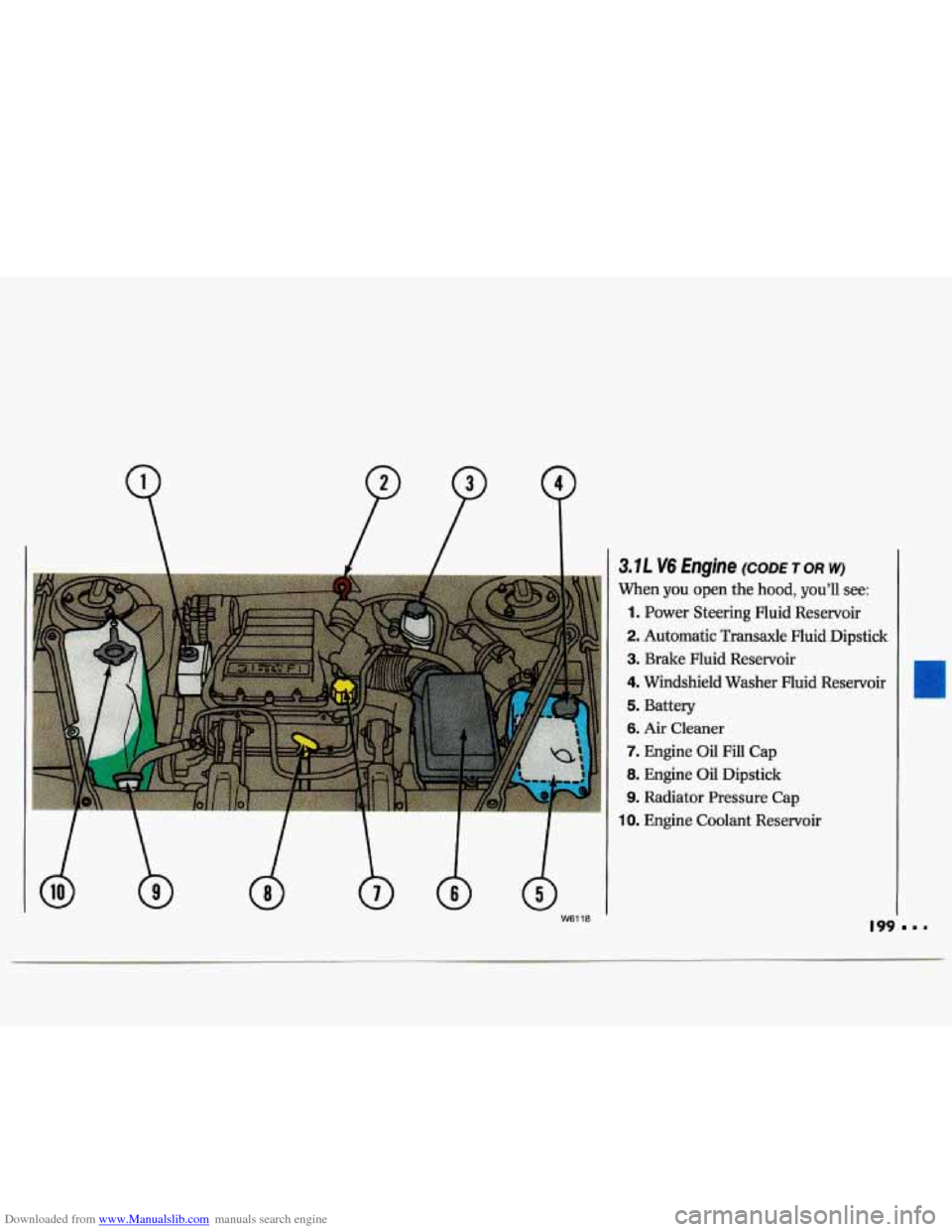
Downloaded from www.Manualslib.com manuals search engine 3.7L V6 Engine (CODE TOR w)
When you open the hood, you’ll see:
1. Power Steering Fluid Reservoir
2. Automatic Transaxle Fluid Dipstick
3. Brake Fluid Reservoir
4. Windshield Washer Fluid Reservoir
5. Battery
6. Air Cleaner
7. Engine Oil Fill Cap
8. Engine Oil Dipstick
9. Radiator Pressure Cap
10. Engine Coolant Reservoir
I99
Page 202 of 324
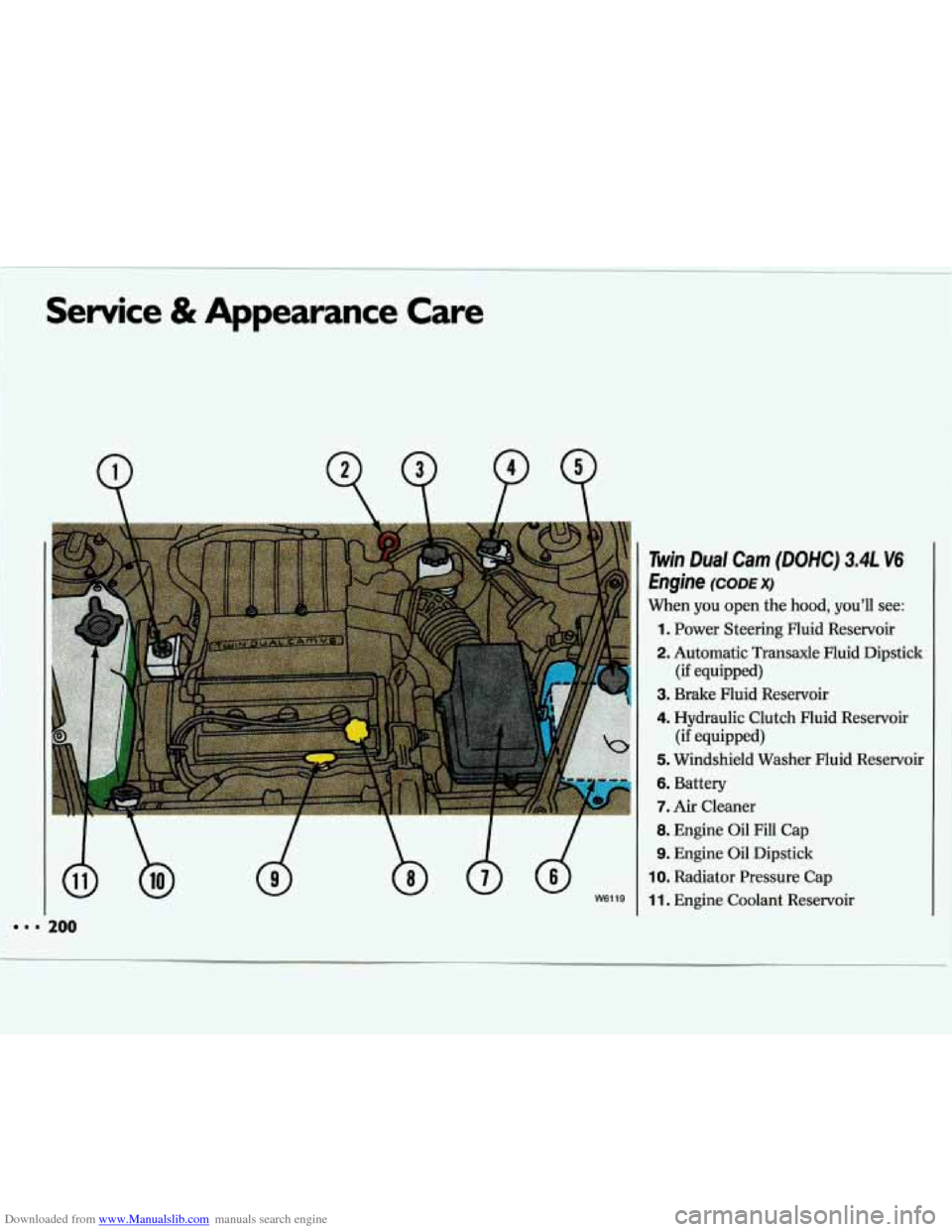
Downloaded from www.Manualslib.com manuals search engine Service & Appearance Care
= 200
W6119
Twin Dual Cam (DOHC) 3.4L V6
Engine (CODE X)
When you open the hood, you’ll see:
1. Power Steering Fluid Reservoir
2. Automatic Transaxle Fluid Dipstick
3. Brake Fluid Reservoir
4. Hydraulic Clutch Fluid Reservoir
5. Windshield Washer Fluid Reservoir
6. Battery
7. Air Cleaner
8. Engine Oil Fill Cap
9. Engine Oil Dipstick
IO. Radiator Pressure Cap
11. Engine Coolant Reservoir
(if equipped)
(if equipped)
Page 209 of 324
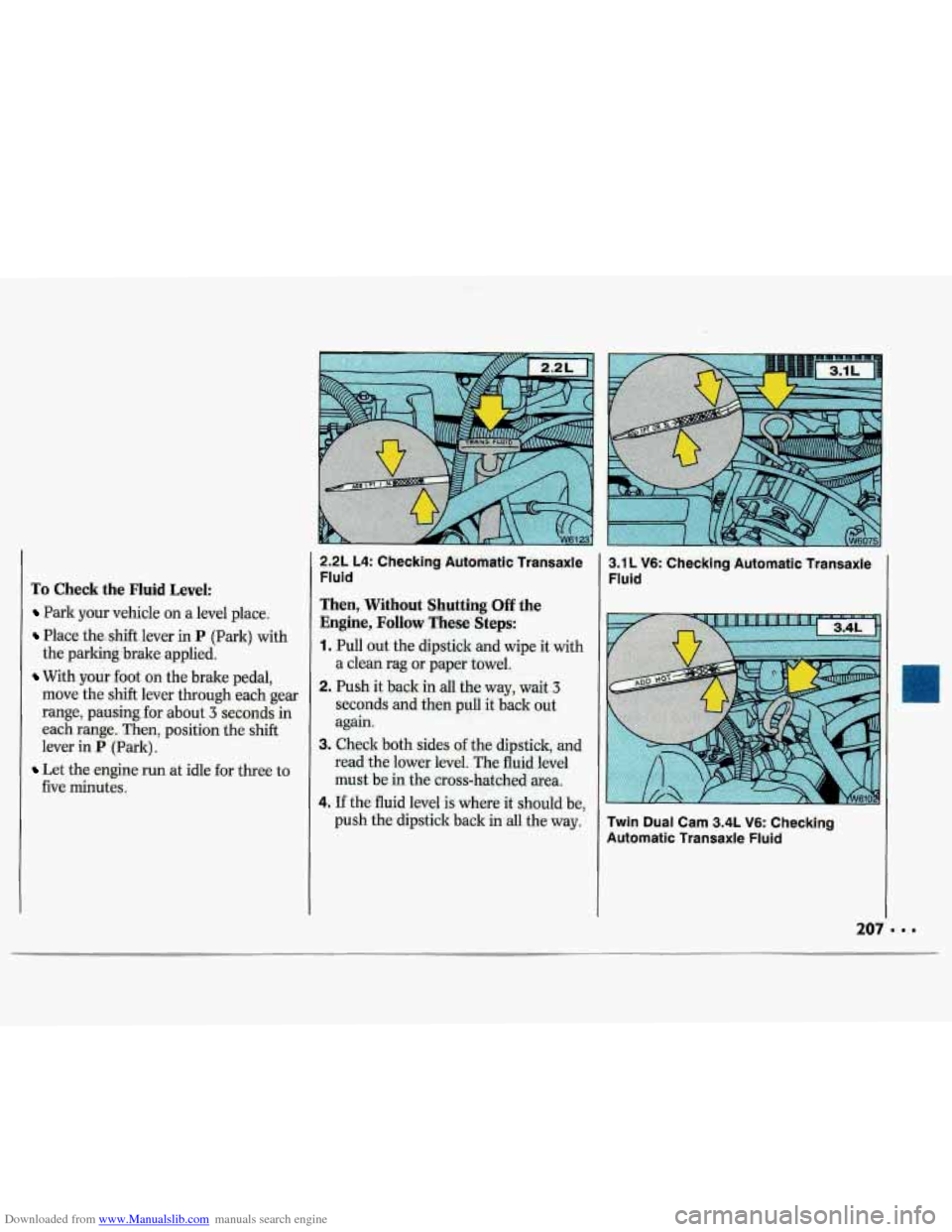
Downloaded from www.Manualslib.com manuals search engine To Check the Fluid Level:
Park your vehicle on a level place.
Place thashift,lever in P (Park) with
With youi foot on the brake pedal,
the
parki_ng'bralce applied.
move the
shift lever through each gear
range,, paysling for about 3 seconds in
each range. Then, position the
shift
lever in P (Park).
Let the engine run at idle for three to
five minutes.
3.1 L V6: Checki,ng..Automattc Transaxle
Fluid
Twin Dual Cam
3.4L V6: Checking
Automatic Transaxle Fluid